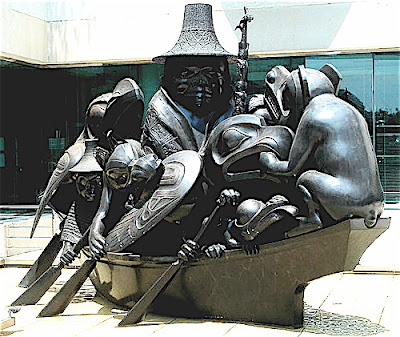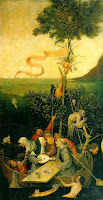 The Spirit of Haida Gwaii, creation, in 1986, of Bill Reid, comes as near as any piece of art to describing my world. I like the idea of a boat, but the much used image of the 'Ship of Fools'
The Spirit of Haida Gwaii, creation, in 1986, of Bill Reid, comes as near as any piece of art to describing my world. I like the idea of a boat, but the much used image of the 'Ship of Fools'  projects our private ugliness - looks and behaviour - as images of shared foolishness, but in the process enjoins mockery of the ugly, the poor, the maimed, the underclasses [Bosch's is the example I know from Foucault's 'Madness and Civilization' used on Psych 171 courses I taught long ago at Michigan]. It's too easy to see a ship crewed by others. Reid's figures, though mainly animals, are us - our polity. I crew this boat; may even aspire to advise its skipper. The image consoles when I'm despondent about democracy - the worst form of government except for the others. 'There is certainly no lack of activity in our little boat,' said Reid, 'but is there any purpose? Is the tall figure who may or may not be the Spirit of Haida Gwaii leading us, for we are all in the same boat, to a sheltered beach beyond the rim of the world ... or is he lost in a dream? The boat moves on anchored in the same place' freighted with creatures who bite and claw as they row. Not a grounded apolitical ship of fools, rather the discordant family of all living things striving to up-anchor and gain steerage amid the dangers of the sea, about which my mentor, Denys Rayner, wrote 'neither cruel nor kind ... Any apparent virtues it may have, and all its vices, are seen only in relation to the spirit of man who pits himself, in ships of his own building, against its insensate power.' (Preface to 'Escort: The Battle of the Atlantic' London:Kimber 1955)
projects our private ugliness - looks and behaviour - as images of shared foolishness, but in the process enjoins mockery of the ugly, the poor, the maimed, the underclasses [Bosch's is the example I know from Foucault's 'Madness and Civilization' used on Psych 171 courses I taught long ago at Michigan]. It's too easy to see a ship crewed by others. Reid's figures, though mainly animals, are us - our polity. I crew this boat; may even aspire to advise its skipper. The image consoles when I'm despondent about democracy - the worst form of government except for the others. 'There is certainly no lack of activity in our little boat,' said Reid, 'but is there any purpose? Is the tall figure who may or may not be the Spirit of Haida Gwaii leading us, for we are all in the same boat, to a sheltered beach beyond the rim of the world ... or is he lost in a dream? The boat moves on anchored in the same place' freighted with creatures who bite and claw as they row. Not a grounded apolitical ship of fools, rather the discordant family of all living things striving to up-anchor and gain steerage amid the dangers of the sea, about which my mentor, Denys Rayner, wrote 'neither cruel nor kind ... Any apparent virtues it may have, and all its vices, are seen only in relation to the spirit of man who pits himself, in ships of his own building, against its insensate power.' (Preface to 'Escort: The Battle of the Atlantic' London:Kimber 1955)In the bow Grizzly Bear faces Bear Mother, their cubs between them. Next is Beaver at home on the ocean floor hoarding the water and fish of the world; then Dogfish Woman with a hooked beak, gills on her cheeks and a pointed head; then Mouse Woman, guide to those passing from the human to the non-human domain. Raven steers. Beneath his wing is a grudging oarsman representing humans who labour to build and rebuild. Athwartships is Wolf with claws in Beaver’s back, his teeth in Eagle’s wing. Beneath Eagle is Frog. The hatted figure is the shaman Kilstlaai, holding a speaker’s staff topped by an Orca.
Unlike the Ship of Fools this boat is a descendant of Jason's Argo and the crews who shared in Ulysses' odyssey, comforting me with my ancestor's maxim 'Except the blind forces of Nature, there is nothing that moves in the world today that is not Greek in origin'. Reid's vessel, introduced to me by the political philosopher Jim Tully ('Strange Multiplicity: Constitutionalism in an Age of Diversity' Cambridge, 1995), who places it on the cover of his book, inspired my favourite paper: Baddeley, S. (1995) 'Internal Polity' Human Relations, Vol. 48, No. 9, 1073-1103 (1995) hum.sagepub.com/cgi/content/abstract/48/9/1073
Abstract: Repression has been a conditional means of civilizing the psyche, but in pluralistic democracies where diversity is valued, where assimilation is not a condition of citizenship and where aspirations are formed within consumerism, this road to self-understanding is unreliable. At a time when neither individualism nor collectivism encourage individuality, the idea of an internal polity enriches self-awareness, strengthening agency in the world. Perhaps.
* * *
 While on mythic boats what of Argo? Here's the artist Engonopoulos' impression of her celebrity crew of argonauts - all progeny of Gods. Someone's sitting on the gunnels gazing at the sea smoking a cigarette (not in an enclosed space). Jason's staring ahead in shades, not exactly leading, but holding a fine steering oar. There's Heracles with a studded club; Orpheus with lyre, and some of the crew in the water, relaxing. Lovely blue. Lots of light. How is this relaxed company going to get all the way from Volos to Colchis at the far end of the Black Sea to steal the Golden Fleece? Perhaps they'll just chill out on the shores of the northern Aegean and make up a brilliant story about their adventures when they get home.
While on mythic boats what of Argo? Here's the artist Engonopoulos' impression of her celebrity crew of argonauts - all progeny of Gods. Someone's sitting on the gunnels gazing at the sea smoking a cigarette (not in an enclosed space). Jason's staring ahead in shades, not exactly leading, but holding a fine steering oar. There's Heracles with a studded club; Orpheus with lyre, and some of the crew in the water, relaxing. Lovely blue. Lots of light. How is this relaxed company going to get all the way from Volos to Colchis at the far end of the Black Sea to steal the Golden Fleece? Perhaps they'll just chill out on the shores of the northern Aegean and make up a brilliant story about their adventures when they get home.* * *
The ship and crew I really want to know more about is the Hercules - a two masted square rigged brig of 120 tons chartered in Genoa by Lord Noel Byron - a collier, therefore tubby, skippered by a Captain Scott - from whose decks the great poet sighted Zante and Cephalonia on 2 August 1823.
 Hercules carried Byron in company with Edward Trelawny, James Hamilton Browne, (author of an account of their voyage from Italy to Greece), Vitali, Count Pietro Gamba, Dr. Francesco Bruno, Constantine Skilitzy, the gondolier Tita Falcieri, the valet Fletcher and steward Lega Zambelli, several other servants, five horses, Byron's bulldog Moretto, and the Newfoundland dog Lyon. After several months wait at Cephalonia, Byron received a summons from Prince Alexander Mavrocordato to come at once to Missolonghi, with a request 'to co-operate...in the organization of western Greece.' The machinations that followed, made more confusing by separate accounts of the events up to Byron's death on the 19 April 1824, have not sullied the historical conclusion that the poet, though he did not die in battle, died for the freedom of Greece.
Hercules carried Byron in company with Edward Trelawny, James Hamilton Browne, (author of an account of their voyage from Italy to Greece), Vitali, Count Pietro Gamba, Dr. Francesco Bruno, Constantine Skilitzy, the gondolier Tita Falcieri, the valet Fletcher and steward Lega Zambelli, several other servants, five horses, Byron's bulldog Moretto, and the Newfoundland dog Lyon. After several months wait at Cephalonia, Byron received a summons from Prince Alexander Mavrocordato to come at once to Missolonghi, with a request 'to co-operate...in the organization of western Greece.' The machinations that followed, made more confusing by separate accounts of the events up to Byron's death on the 19 April 1824, have not sullied the historical conclusion that the poet, though he did not die in battle, died for the freedom of Greece.I would like also to know about the ships of Admiral Lascarina Bubulina of Spetses who fought
 in the Greek War of Independence, having been born in a Constantinople prison. In 1811, twice widowed, the mother of seven children, rich by inheritance from her husbands, Bouboulina managed to increase her fortune by astute trading, becoming partner in several Spetsiot vessels, building three of her own, including the Agamemnon - the first and largest Greek fighting ship of the 1821 War of Independence. I only learned this because she was mentioned in a commentary by Michael Cacoyannis explaining why Zorba called Madame Hortense 'Bouboulina'.
in the Greek War of Independence, having been born in a Constantinople prison. In 1811, twice widowed, the mother of seven children, rich by inheritance from her husbands, Bouboulina managed to increase her fortune by astute trading, becoming partner in several Spetsiot vessels, building three of her own, including the Agamemnon - the first and largest Greek fighting ship of the 1821 War of Independence. I only learned this because she was mentioned in a commentary by Michael Cacoyannis explaining why Zorba called Madame Hortense 'Bouboulina'.
No comments:
Post a Comment